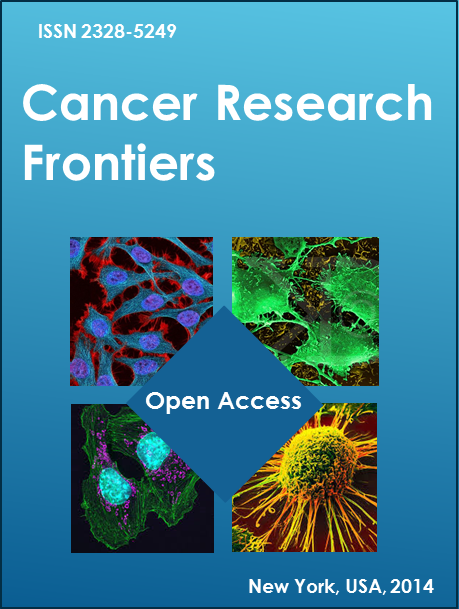All types of contribution to Cancer Research Frontiers, except editorials, are peer-reviewed. The peer review process focuses on whether the work is done to high scientific and ethical standards and is appropriately described, and that the data support the conclusions. The role of peer review is considered to be helping authors improve their manuscripts rather than deciding whether they should be published. The editor makes the final decision.
Cancer Research Frontiers aims to provide authors with professional, fair, timely and confidential peer reviews by experts in the field. The review consists of the following steps:
1. Initial Screening
After a paper is submitted to a journal, a Managing Editor screens the manuscript and decides whether or not to send it for full peer review. This is to ensure adherence to our policies, including statement of competing interests, ethical requirements for studies involving human participants or animals, as well as unacceptably low standard language. For example, the editor will ask:
- Does the manuscript fit the journal’s scope and will it be of interest to the readership?
- Is the manuscript of acceptable quality? Is the writing good enough to make it worth reviewing?
- Is the manuscript compliant with the journal’s instruction for authors?
The author(s) may be asked for revision. Only after clearing the initial screening is the manuscript sent to peer reviewers. Manuscripts may be declined by the Managing Editor, without a full review, nor being asked for revision, if they are inconsistent with our Editorial Guidelines.
2. Review
Manuscripts are assigned by the Managing Editor, to one of the Editorial Board member, and two to four reviewers. External referees are consulted when additional expertise is required. All reviewers are working scientists and therefore are in the best position to judge the quality and importance of the work. All board members and referees who review a manuscript remain unknown to the authors. Every manuscript is treated by the editors and reviewers as privileged information, and they are instructed to exclude themselves from review of any manuscript that might involve a conflict of interest. The reviewers make a recommendation to accept, revise, or decline a paper based upon the scientific merit and technical quality of the studies reported. The primary criteria for judging the acceptability of a manuscript are its novelty and scientific importance, i.e., novel and important contributions to understanding the molecular, cellular and clinical basis of cancer etiology, development, and treatment. See Guideline for Reviewers.
3. Decision
Editors have the option of accepting, recommending modification, recommending additional external review, or rejecting. If the decision is Minor Revision or Major Revision, authors have 30 days to resubmit a revised manuscript. Upon resubmission, the academic editor may choose to return the manuscript to the reviewers, or may render a decision based on his/her personal expertise. Cancer Research Frontiers aims to provide authors with an initial decision within four weeks. After acceptance, manuscripts are published online within one week after proof-reading.
4. Proof reading
You can annotate and add comments in a Word document. If, for any reason, this is not possible, mark the corrections and any other comments on a printout of your proof and return by scan the pages and email to . Please use this proof only for checking the typesetting, editing, completeness and correctness of the text, tables and figures. Significant changes to the article as accepted for publication will be considered at this stage only with permission from the editor. We will do everything possible to get your article published quickly and accurately; please reply with your corrections within 48 hours. Proofreading is solely your responsibility. Note that Cancer Research Frontiers may proceed with publication of your article, with no further editing, if no response is received.
5. Complaint policy

FAQ for Peer Review Process:
Q1. How are the peer reviewers identified, and who makes the final selection of the peer reviewers?
All manuscript submitted to CRF that are selected for peer review are sent to two-four independent reviewers, selected by the editors. Authors are welcome to suggest suitable independent reviewers and may also request that the journal excludes individuals or laboratories. The editor will carefully consider such requests, since studies have found that author recommended peer reviewers tend to recommend acceptance more often than journal recommended reviewers.
Peer reviewers are ideally experts in their field. We have built a panel of over 300 peer reviewers that have a good track record of producing high quality reviews. We scanned the bibliography to identify potential reviewers or contact researchers we met at conferences and seminars.
Reviewer selection is critical to the publication process, and the editors will base their selection on many factors, including expertise, publication records, reputation, prior reviewing experience or personal knowledge and specific recommendations. The editors will avoid using people who are slow, careless, or do not provide reasoning for their views.
The editors will check with potential reviewers before sending them manuscripts to review. Reviewers should bear in mind that these messages contain confidential information, which should be treated as such.
Editors will make the final selection of peer reviewers who have sufficient expertise to fairly judge the manuscript.
Q2. Who assesses the reviewer reports and makes a decision on the submission, and how is the final decision reached?
We ask peer-reviewers to submit their reports via our secure online system by following the link provided in the editor’s email.
The editors can assess these reviewer reports and make all decisions (acceptance, rejection, and revision). Editorial decisions are not a matter of counting votes or numerical rank assessments, and we do not always follow the majority recommendation. The editors try to evaluate the strength of the arguments raised by each reviewer and by the authors, and may also consider other information not available to either party. Our primary responsibilities are to our readers and to the scientific community at large, and in deciding how best to serve them.
It is common for peer reviewers to give conflicting feedback on the same manuscript, and the Editor seeks to offer guidance to authors on how to proceed in pursuing a revision. The journal editor might choose to send the paper to another reviewer before arriving at a decision, and the author may have to wait longer for the peer review process to be completed.
In breif, the editor who handles papers reach a decision to accept or reject papers based on reviewers’ comments and their own opinion of the papers’ publication worthiness.
Q3. Who communicates the decision to the authors?
The editor who handles the manuscript.
Q4. How is the revised manuscript assessed?
There are three options for the editors
(1) Editor makes decision based on the revision and his/her own experience, without sending a resubmitted paper back to the reviewers;
(2) Back to reviewers
We ask that reviewers should be willing to provide follow-up advice as requested. Revised manuscripts, along with the document detailing the authors’ responses to the reviewers’ comments and related text changes, are normally returned to the original panel of reviewers for reassessment, especially when
(2a) the original concerns were substantial, or
(2b) the reviewers disagree with each other, or
(2c) where the authors believe they have been misunderstood on points of fact.
(3) Additional reviewers
We occasionally bring in additional reviewers to resolve disputes between reviewers, but we prefer to avoid doing so unless there is a specific issue, for example a specialist technical point, on which we feel a need for further advice.
The acceptance of a revised manuscript is not guaranteed, but the decision letter will usually provide general guidance intended to be helpful in achieving that end.
Q5. What is the role of the editorial board in the peer review process?
The editorial board has the ultimate responsibility and authority for the editorial decision-making.
Q6. Who is responsible for the final decision to accept, revise or reject the article?
The editor who handles the manuscript.








